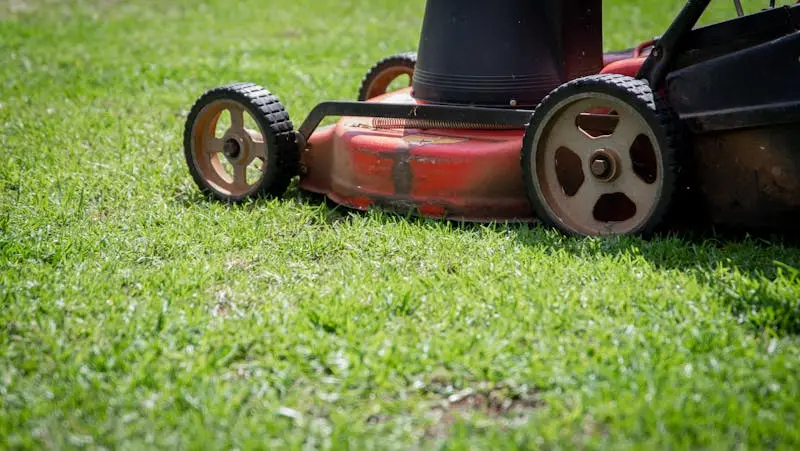Do you want a lush green lawn that looks neat and healthy? Cutting grass might sound like an easy task, but there’s more to it than just pushing a mower around. Whether you’re using a manual lawn mower, a petrol one, or a robot mower, knowing the right way to mow can make all the difference.
In this guide, we’ll show you how to cut grass properly, what tools you need, when to mow, and tips to keep your lawn looking great all year. Let’s get started!
Why Mowing Your Lawn the Right Way Matters
Mowing your lawn is not just about making it look nice. It also helps:
- Promote healthy grass growth
- Prevent weeds from taking over
- Keep pests away
- Improve the lawn’s overall strength
When grass is cut properly, it grows thicker and greener. Bad mowing habits, on the other hand, can stress your lawn, weaken the roots, and leave bald or brown patches.
Tools You Need to Cut Grass
Before you begin, make sure you have the right tools for the job:
1. Lawn Mower
Choose a mower that fits the size and shape of your lawn:
- Push Mowers – Great for small lawns.
- Electric or Petrol Mowers – Better for medium to large lawns.
- Robot Lawn Mowers – Best for busy homeowners who want a hands-free mowing solution.
2. Grass Trimmer (Optional)
To trim around garden beds, trees, or fences where the mower can’t reach.
3. Rake or Lawn Sweeper
For collecting grass clippings if you’re not using a mulching mower.
Step-by-Step: How to Cut Grass with a Lawn Mower
Here’s a simple step-by-step guide for mowing your lawn the right way.
Step 1: Prepare the Lawn
- Pick up sticks, rocks, or toys from the grass. This keeps the mower blades safe and prevents accidents.
- Check if the grass is dry. Wet grass clumps together and can block the mower.
Step 2: Set the Cutting Height
- Most people cut grass too short. That’s a mistake!
- A good rule is to never cut more than 1/3 of the grass height at once.
- Ideal grass height is 2.5 to 4 inches depending on the grass type.
- Taller grass helps shade the soil, keeping it cool and stopping weeds.
Step 3: Start Mowing in a Pattern
- For small yards, go in straight lines back and forth.
- In bigger lawns, try mowing in a different direction each time – horizontal one week, vertical the next. This avoids creating ruts and helps the grass grow straight.
- Overlap each row slightly to avoid missing patches.
Step 4: Use a Mulching Feature (If Available)
- Many modern mowers can mulch the grass.
- This means the mower cuts the clippings into tiny pieces and drops them back on the lawn.
- These clippings act like a natural fertilizer.
Step 5: Trim Edges (Optional)
- Use a grass trimmer or edger to clean up the lawn’s edges near fences, walkways, or garden beds.
Step 6: Clean the Mower After Use
- After mowing, turn off the mower and clean grass clippings from underneath the deck.
- If using a robot mower, check its blades and remove any dirt or debris.
Bonus: How to Use a Robot Lawn Mower?
Robot mowers are a great solution for modern lawn care. If you own one, here’s how to get the best results:
- Set boundaries with wires or GPS so the mower knows where to go.
- Program the schedule to mow regularly – many models cut the grass a little each day, which is actually healthier.
- Check the blades once a week to make sure they are sharp and clean.
- Keep the robot charged and store it in its docking station.
Robot mowers like the MoeBot, Husqvarna Automower, and Worx Landroid are designed to handle small to large lawns and work well even on slopes.
Common Mowing Mistakes to Avoid
Even experienced gardeners make mistakes when mowing. Avoid these common ones:
- Cutting too short (Scalping): Weakens grass and encourages weeds.
- Using dull blades: Tears grass instead of cutting it, leaving brown tips.
- Mowing wet grass: Leaves clumps and can damage your mower.
- Always mowing in the same direction: Causes soil compaction and rut marks.
- Not mowing often enough: Tall grass gets harder to cut and can stress your mower.
When is the Best Time to Mow?
Timing matters! Here are a few tips:
- Mid-morning (8–10 AM) is ideal – the dew has dried, and it’s not too hot yet.
- Evening (4–6 PM) is also okay – just make sure the grass is dry.
- Avoid mowing during midday heat or right after rain.
How Often Should You Mow?
The mowing frequency depends on the grass type and season:
- Spring & Summer: Once a week (or more for fast-growing lawns).
- Fall: Every 10–14 days.
- Winter: Rarely, if ever – grass grows slower.
Use the “1/3 Rule” – if grass is getting tall, only remove one-third of its height at a time.
Tips for a Healthier Lawn
- Sharpen your mower blades every 1–2 months.
- Leave clippings on the lawn (unless they’re too thick).
- Water deeply but not too often. Early morning watering is best.
- Fertilize as needed, especially in spring and fall.
- Aerate the lawn once a year to let air and water reach the roots.
Should You Buy a Robot Mower?
If you’re short on time or just want a perfectly mowed lawn without the effort, robot mowers are worth it. They:
- Mow regularly for consistent lawn health
- Work quietly and automatically
- Use smart tech like GPS or sensors
- Are safe around pets and kids
- Save you hours every month!
Look for features like:
- Large cutting decks
- Obstacle detection
- Smartphone control
- Weather sensors
- Multi-zone support
So, What’s Next?
Cutting grass may seem like a simple job, but doing it right can completely change the look and health of your lawn. Whether you’re using a basic push mower or a high-tech automatic lawn mower, following the right steps ensures your grass stays green, even, and strong.
Remember to mow regularly, use sharp blades, and follow the 1/3 rule. With these easy tips, anyone can have a beautiful lawn that stands out in the neighborhood.
Ready to level up your lawn care? Choose the right mower, follow our simple guide, and enjoy a greener tomorrow!
Read Also: How to Sharpen Blades on a Lawn Mower

